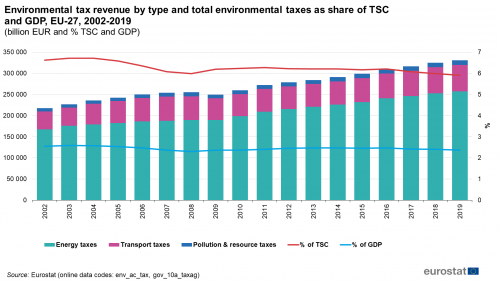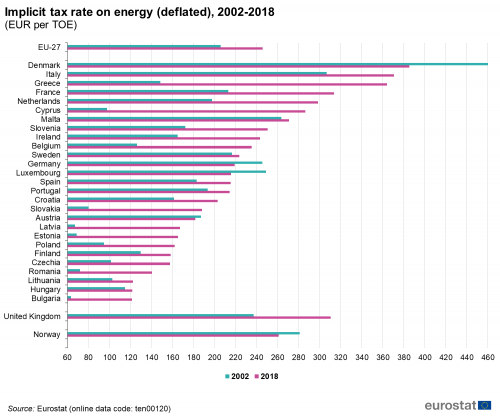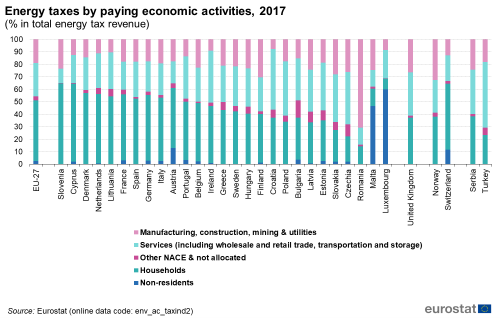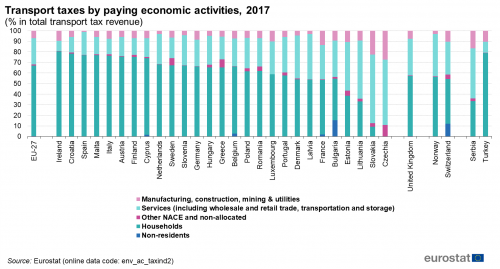Test Wendy 2
Data extracted in Jan 2020.
Planned article update: March 2021.
Highlights
The EU raised €330.6 billion from environmental taxes in 2019.
Energy taxes represented more than three-quarters of EU environmental tax revenue in 2019.
Environmental taxes, % of total taxes and social contributions, 2002 and 2018
This article presents the results of a detailed analysis of data on environmental taxes in the European Union (EU), complementing the article on environmental tax statistics. It provides information on evolution, drivers and payers of environmental tax revenue.
An environmental tax is a tax whose tax base is a physical unit (or a proxy of it) of something that has a proven, specific negative impact on the environment and which is defined in the European System of Accounts (ESA 2010) as a tax.
Full article
General overview
In 2019, EU environmental tax revenue amounted to EUR 330.6 billion, accounting for 5.9 % of total government revenue from taxes and social contributions (TSC) [1]).
Figure 1 presents the level, structure and evolution of the EU environmental tax revenue.
In 2019, the EU-27 environmental tax revenue amounted to EUR 330.6 billion, accounting for 5.9 % of total government revenue from taxes and social contributions and 2.4 % of the EU gross domestic product (GDP) GDP.
Between 2002 and 2019, environmental taxes grew by 52 % (EUR 113.0 billion) in nominal terms. Compared with 2018, the 2019 environmental tax revenue increased by 1.7 % (EUR 5.6 billion), i.e. at a rate significantly lower than its average annual growth rate since 2002 of 2.5 %.
In 2019, environmental tax revenue-to- GDP ratio for the EU amounted to 2.37 %, having fallen slightly - by 0.18 percentage points - in the 17 years under analysis (from 2.55 % in 2002). Over the same period, the share of environmental tax revenue in total government revenue from taxes and social contributions (TSC) decreased by 0.7 percentage points, from 6.6 % to 5.9 %.

The European Green Deal acknowledges the crucial role of taxation in the transition towards a greener and more sustainable European growth and the need to better align our taxation systems with EU climate objectives. Well-designed tax reforms can indeed boost economic growth, help reduce greenhouse gas emissions by ensuring an effective carbon pricing and contribute to a fair transition.
The Roadmap to a Resource Efficient Europe (European Commission, 2011) included the following milestone: by 2020, a major shift from taxation of labour towards environmental taxation will lead to a substantial increase in the share of environmental taxes in government revenue, in line with the best practice of EU countries.
With the downward trend observable for the ratio of the environmental taxes to total tax revenue, no major progress has been made in the implementation of the resource efficiency policy objective. Even though the equivalent ratio for labour taxes started to fall already during the financial crisis (2009), both shares declined from 2011 to 2015. With labour taxation remaining rather stable in recent years, and environmental taxes significantly decreasing since 2016, both shares reached in 2018 a similar level as recorded in 2008 (for details, see Figure 2). Environmental taxes-to-total taxes and social contributions ratio, however, continued its downward path in 2019, whereas the ratio for labour taxes retained the level from the previous year. Consequently, the share of labour taxes in total taxes and social contributions (at 51.7 % in 2019) remains more than eight times higher than the equivalent share for environmental taxes.
Energy taxes stand out as the major source of EU environmental tax revenue
Energy taxes represent more than three quarters of EU-27 environmental tax revenue in 2019
Environmental tax revenue is broken down into four main categories: (i) energy taxes, (ii) transport taxes, (iii) pollution taxes and (iv) resource taxes. Given the small share of pollution and resource taxes in total environmental tax revenue and the problems in assigning some minor national taxes to one of the tax categories, these two types of taxes have been grouped together in this article when presenting the structure of the environmental taxes.
Energy taxes include taxes on energy products (e.g. coal, oil products, natural gas and electricity) used for both stationary purposes and transport purposes. In 2019, the vast majority of environmental tax revenue (77.9 %) came from energy taxes. By convention, CO2 taxes are also included in this tax category as they are usually levied on energy products.
It should be noted that the energy taxes for some countries do not include the levies imposed within the ring-fenced schemes to finance the transition to other renewable energy sources, e.g. the German Renewable Energy Sources Act (EEG).
Transport taxes mainly include taxes related to the ownership and use of motor vehicles. In 2019, transport taxes were the second largest source of environmental tax revenue in the EU, accounting for 18.9 % of the total.
Pollution and resource taxes cover different types of taxes: taxes on the extraction of raw materials; on measured or estimated emissions to air (e.g. NOx, SO2) and water; on noise and on the management of waste. Only 3.2 % of EU-27 total environmental tax revenue was raised from pollution and resource taxes in 2019.
Since 2002, distribution of the tax categories has remained roughly the same, with no or very small changes (by less than 1 percentage point) in the share of energy taxes, transport taxes and pollution/resource taxes in total. As energy tax revenue accounts for around 78 % of environmental taxes, its development determines to a large extent the trend for the total revenue of environmental taxes. In 2019, EU revenue from energy taxes (in nominal terms) was around EUR 90 billion higher than in 2002. This corresponds to an increase of 54 %. The growth rate of other environmental taxes over the same period was lower. Transport taxes increased by 47 % (EUR 20 billion), and taxes on pollution and resources by 34 % (EUR 3 billion).

Source: Eurostat (env_ac_tax)
CO2 taxes as a distinct sub-category of energy taxes
CO2 taxes or carbon taxes are levied on the carbon content of fossil fuels. While all energy taxes increase the price of energy products, CO2 taxes must have a clear tax base (carbon content). Consequently, a CO2 tax, which makes this type of tax distinct compared with other energy taxes, also provides an incentive to use a fuel with lower carbon content.
CO2 taxes are regarded as a borderline case between energy and pollution taxes. However, they are recorded as energy taxes in EU statistics given that they are levied on energy products and have usually been introduced as a substitute for other energy taxes. The revenue from these taxes can be substantial compared with the revenue from pollution taxes, and the recording of CO2 taxes with pollution taxes would distort both the time series at national level and an international comparison.
In recent years, several EU countries have introduced a carbon tax which ranges from less than €1 per metric ton of carbon in Poland to over €100 in Sweden. Such taxes are also levied in Denmark, Slovenia, Ireland, France, Finland, Portugal, Latvia and Estonia. Since January 2021, also Germany and Luxembourg have followed and Austria has plans for implementation of a CO2 tax in 2022. Within non-EU European Free Trade Association (EFTA) countries, Norway has such a tax. Apart from country-specific levies, the EU CO2 taxes also cover government revenue from the auctions of emission permits under the EU Emissions Trading System (EU ETS), which are recorded by all EU Member States.
Emission permits
The payments collected by EU Member States for emission permits (emission allowances) are one example of CO2 taxes. Under the European System of Accounts 2010 (ESA 2010), i.e. the accounting standards underpinning compilation of macro-economic statistics (National Accounts), the ETS auction revenues are recorded as taxes. Please note that ESA 2010 accounting rules are followed for compilation of all the taxation data presented in this article, including the ETS revenue described in this section. Governments are increasingly using such emission trading systems, based on a cap and trade principle, to control total CO2 emissions. The EU ETS was introduced in 2005. Up to 2012, governments allocated allowances for free. However, auctioning has been the default method for allocating allowances within phase 3 (2013-2020) of the EU ETS. In 2013, over 40 % of the allowances were auctioned; this proportion has been increasing over recent years, and is expected to further increase. In phase 4 of the EU ETS (2021-2030), the overall number of emission allowances will further decline. The system of free allocation will be re-focused on sectors at the highest risk of relocating their production outside of the EU. These sectors will receive 100 % of their emission permits for free. For less exposed sectors, free allocation is foreseen to be phased out after 2026. A considerable number of free allowances will be set aside for new and growing installations. Under ESA 2010, governments should record the proceeds from an auction of emission trading allowances as other taxes on production (D.29) and on an accrual basis (i.e. at the time of CO2 emissions covered by a permit, meaning only in the year when the permits are used (surrendered) and not when they are auctioned). Total CO2 tax revenue relating to EU ETS allowances reported by EU countries amounted to EUR 12.2 billion in 2019. In comparison, the value in the preceding years was significantly lower, ranging from EUR 3.0 billion to EUR 3.9 billion per year in the period 2014-2017, and EUR 7.1 billion in 2018. For 2019, the value corresponds to a share of around 4.7 % of the total revenue from energy taxes in the EU. The decreasing number of free-allocated emission trading allowances in the EU and EFTA countries explains to some extent the evolution of the ETS revenue in the recent years. Germany recorded by far the largest tax revenue from emission permits in the EU (EUR 2.8 billion in 2019), followed by Italy (EUR 1.3 billion), Poland (EUR 1.2 billion) and Spain (EUR 1.0 billion) (see Figure 3).
Evolution of environmental tax revenue in Europe between 2002 and 2019
For over half of the EU Member States, the share of environmental taxes in total taxes and social contributions (TSC) has decreased or remained unchanged
Figure 4 compares the share of environmental taxes in TSC for 2002 with 2019. In 16 EU Member States the share decreased, whereas for 11 countries, it increased. In particular, Estonia moved towards a greener taxation system, increasing the share of environmental taxes in TSC by 3.2 percentage points, from 6.4 % in 2002 to 9.6 % in 2019, the largest increase in the EU-27 (for increases, see the right-hand axis and green dots in Figure 4; for shares in TSC, see the left-hand axis and bars). The rise in the share of environmental taxes in TSC in Estonia can be mainly explained by an increase in the revenue from fuel excises (higher by more than five times in 2019 compared to 2002) and a large increase in 2019 in revenue from the sale of emission permits. Greece also achieved a remarkable increase in the environmental taxes-to-total taxes and social contributions ratio, by 2.9 percentage points compared with 2002, i.e., to 9.8 % in 2019. Four new environmental taxes have been introduced in Greece since 2002, helping to boost the tax revenue.
Between the countries with a descending trend, Denmark records the highest decrease between 2002 and 2019 from 11.0 % to 7.1 % of TSC, i.e., by of 3.9 percentage points, followed by Lithuania, with a decrease of 3.4 percentage points (from 9.7 % to 6.3 %). The share for Luxembourg and Malta also fell significantly (by 2.6-2.7 percentage points) since 2002. For decreases, see the dots in blue below the grey-dashed line in Figure 4.
Main drivers behind the evolution of environmental taxes
This section focuses on how environmental tax revenue and its main components - energy taxes and transport taxes - have evolved, compared with recent developments in the EU economy as a whole and the key related economic and fiscal indicators.
Figure 5 outlines the trend in GDP, total tax revenue, energy taxes, transport taxes and pollution/ resource taxes from 2002 to 2019. The metrics are all indexed for comparability.
The financial crisis reversed the upward trend observed for economic aggregates in 2002-2007/2008. Energy taxes were less affected by the crisis and continued to grow, albeit very slightly during the years 2007-2009. GDP, total tax revenue, transport and pollution/resource tax revenue sharply fell in 2009.
In the years before 2007, transport taxes increased at a faster pace than GDP and the other taxes under examination. Following the financial crisis, the economy, and the total tax revenue, grew at a faster pace than environmental taxes in the EU.
Evolution of energy taxes and the implicit tax rate (ITR) on energy
Even though the EU energy taxes consistently grew between 2002 and 2019 (with the pace of its growth changing in 2006, 2009 and very slightly in 2016), EU-27 energy tax revenue-to-GDP ratio dropped by 0.1 p.p., i.e. by 6 % from 2002 to 2019 (see Figure 6). Most of this decrease in the ratio occurred in 2005-2008, when GDP grew at a faster pace than energy tax revenue. Final energy consumption has remained relatively stable between 2002 and 2019. Its link with energy tax revenue is examined in more detail on Figures 7-8.
Energy intensity is calculated as the ratio between the sum of inland consumption of solid fuels, oil, gas, nuclear and renewable energy sources and GDP. The indicator is expressed in chain linked volumes of GDP as it allows for a better comparison between different time periods (see Figure 7). Since 2002, energy intensity has been gradually decreasing, dropping by almost 25 % by 2019, with the trend mainly driven by an overall rise in the GDP over this period, in particular following the financial crisis.
The relation between the deflated revenue from energy taxes and final energy consumption illustrates the implicit tax rate (ITR) on energy. It should be noted that final energy consumption has remained on a rather constant level since 2002, with only minor fluctuations. Final energy consumption measures the total energy consumed by end users, such as households, industry and agriculture. It is the energy which reaches the final consumer’s door and excludes that which is used by the energy sector itself. Consequently, in the years under examination, the evolution of ITR is mainly driven by the development of energy taxes.

The consumption of solid fossil fuels has fallen significantly since 2002. On the other hand, consumption of renewable energy almost doubled between 2002 and 2018. The deflated value of energy taxes seems unaffected by these developments and remained rather stable until 2009. A marked change in the development of energy taxes is observable after 2009. After 2009 the revenue consistently increased (albeit at a moderate speed), reaching a 20 % increase in 2018 compared with 2009. This evolution could be driven by increased tax rates or the introduction of new taxes.

Given the ongoing decrease in energy consumption and a slower growth of energy taxes in recent years, the ITR on energy for the EU-27 increased between 2002 and 2018, from 206 to 246 EUR per TOE (see Figure 9). The ITR and its changes vary significantly across the EU. The highest level of ITR in both 2002 and 2018 was in Denmark (in 2002 more than twice the value of the ITR for the EU-27) with the lowest in Bulgaria (in 2018 half of the EU-27 level). The energy tax rate increased in 2018 from 2002 levels in most of the EU countries (with the highest increase of 216 EUR per TOE in Greece, followed by 188 EUR per TOE in Cyprus), except for Denmark, Germany, Luxembourg and Austria where it decreased by between -5 and -75 EUR per TOE.

Evolution of transport taxes
Transport taxes are levied mainly on vehicles when they are sold (e.g. sales taxes) and then for each year they are licensed for use on the road (e.g. circulation tax). As a result, the revenue from transport taxes tends to follow the dynamics of vehicle sales and vehicle stocks. These two factors might partly explain the reduction in transport tax revenue after 2007 and the gradual recovery since 2009 (see Figures 10 and 11).
The number of new vehicle registrations in the EU-27 decreased between 2007 and 2013 (see Figure 10). In countries with high car sales taxes, the economic downturn impacted on car sales and therefore on revenue from such taxes. However, demand started to pick-up again from 2014, surpassing pre-crisis levels by 12 % in 2018.

Overall, as illustrated in Figure 11, the stock of goods vehicles (+ 33 %), passenger cars (+ 25 %), and buses and coaches (+ 8 %) increased in the period 2002-2018.

Environmental taxes by payer
Resident households and corporations with nearly equal contributions in the energy tax revenue
In the EU, households paid almost half (49 %) of all energy tax revenue collected by governments in 2017. The contribution of corporations, mainly from services and manufacturing sectors, was identical (49 %). The remainder (2 %) relates to the amounts payable by non-residents.
Among the EU Member States, Luxembourg stands out with the largest share of the energy tax revenue (60 %) collected from non-residents, largely due to non-resident purchases of petrol and diesel. In Malta, this share is also substantial (47 %).
In 2017, households paid over 60 % of total energy taxes in Slovenia (65 %) and Cyprus (62 %) (see Figure 12).
The services sector (including transportation and trade) accounted for 27 % of the EU energy tax revenue, with Croatia, Poland, Czechia and Ireland recording the shares of over 40 %. Manufacturing, construction, mining and utilities generated 19 % of the EU energy tax revenue.

Households pay over two thirds of the EU transport taxes
On average, transport taxes paid by households accounted in 2017 for a larger share (67 %) of the EU transport taxes than those paid by corporations (33 %) (see Figure 13). This is because households are the main payer of the motor vehicle tax revenue (an important component of transport tax revenue) in the EU.
However, in some Member States the structure of transport tax revenue by payer differs considerably, with households contributing only marginally to transport tax revenue, as in Czechia (0.1 %) and Slovakia (9.2 %).

Households pay slightly more than half of the EU taxes on pollution and resources
For the two combined tax categories, households pay a bit more than half of the tax revenue. This is because higher amounts are generated from taxes on household waste or sewage, wastewater, water abstraction, plastic bags, hunting and fishing taxes, etc. As already mentioned, pollution and resource taxes account for a very small share of the environmental tax revenue. For two countries, the taxes are levied on a small number of payers in some industries, and, as such, the data are subject to statistical confidentiality and related EU aggregates cannot be disclosed either. For this reason, for the EU, Estonia and Lithuania, the presentation of the breakdown by payer has been adjusted (see Figure 14).
In the EU, on average, in 2017, 56 % of all revenue from pollution and resource taxes were levied on households. In particular in the Netherlands and in France, households are the main payers of these taxes (accounting for –respectively - 74 % and 69 % of total environmental tax revenue from these taxes). In Germany and Greece, no taxes existed in 2017 which would fit the definition of a pollution or resource tax. In five other EU countries, these types of environmental taxes are collected, but none of such taxes or only their negligible share is levied on households. This is the case in Croatia, Lithuania, Slovakia, Sweden and Estonia (see Figure 14). In Spain, corporations from the electricity, gas, steam and air conditioning supply sector pay about three-quarters of all pollution and resource taxes. In Romania, only mining and quarrying activities are subject to the taxation.

Source data for tables and graphs
Data sources
Eurostat uses table 9 from the ESA transmission programme to gather data on environmental tax revenue for four categories of environmental taxes (energy, transport, pollution and resources). It also collects data on environmental taxes at a more detailed level, by economic activity. A Eurostat publication entitled ‘Environmental taxes - a statistical guide’ constitutes the methodological basis; statistics on environmental taxes are based on Regulation 691/2011 of 6 July 2011 on European environmental economic accounts (Annex II) as amended by Regulation (EU) 538/2014, as well as on legal acts in the area of national accounts. Data transmission became obligatory in September 2013. Prior to this, Eurostat collected the data on a voluntary basis.
Data relating to environmental taxes can be used to analyse the revenue stream from such taxes, as well as provide a relative measure of the importance of these taxes by calculating ratios relative to GDP or the total revenue from all taxes and social contributions. In the first case, the comparison helps to provide an understanding of the tax burden. In the second case, the comparison helps assess whether or not there is a shift towards environmental taxes - in other words, shifting the tax burden from other taxes (for example those on labour income) towards environmental taxes.
Environmental tax revenue can also be allocated according to the different economic activities that pay the taxes. Eurostat collects data on environmental taxes using a breakdown by economic activity (NACE Rev. 2 classification) supplemented by information for households, non-residents and a category not allocated.
Rising revenue from environmental taxes should be interpreted with caution. The increases may be caused by new taxes or an increase in tax rates, or may be linked to an increase in the tax base.
Context
Economic instruments for pollution control and natural resource management are an increasingly important part of environmental policy in the EU countries. These include among others environmental taxes, fees and charges, tradable permits, deposit-refund systems and subsidies.
Environmental taxes have been increasingly used to influence the behaviour of economic operators, whether producers or consumers. The EU has increasingly favoured these instruments because they provide a flexible and cost-effective means for strengthening the 'polluter-pays' principle and for achieving environmental policy objectives.
Environmental policy aims to achieve environmental and sustainable development goals. Policy makers use incentive-based tools to ensure that environmental solutions are found at the lowest cost, to correct externalities and/or raise revenue for specific purposes.
The environmental tax revenue measured as share of the all taxes and social contributions is an indicator to help assess progress towards 'greening' the taxation system. Part II of the Working Paper on the Roadmap to a Resource Efficient Europe recommends that 10 % of taxes and social contributions in the EU are environmental taxes by 2020. This indicator reflects a certain degree of internalisation of environmental impacts in the national economies.
Direct access to
- Environmental taxes, see:
- Environmental taxes, see:
- Taxation trends in the European Union - Data for the EU countries, Iceland and Norway, 2019 edition
- Tax revenue statistics
- Energy, transport and environment statistics - Eurostat Statistical books, 2019
- Key figures on Europe - 2019 edition - Eurostat Statistical books, 2019
- Environmental taxes - a statistical guide - 2013 edition - Eurostat Statistical books, 2013
- Environmental taxes by economic activity (ESMS metadata file — env_ac_taxind_esms)
- Environmental tax revenue (ESMS metadata file — env_ac_tax_esms)
- Implicit tax rate on energy (ITR) (ESMS metadata file — ten00120_esmsip)
European Commission
Taxation and Customs Unit
Organisation for Economic Co-Operation and Development (OECD)
European Environment Agency (EEA)
Notes
- ↑ excluding imputed social contributions